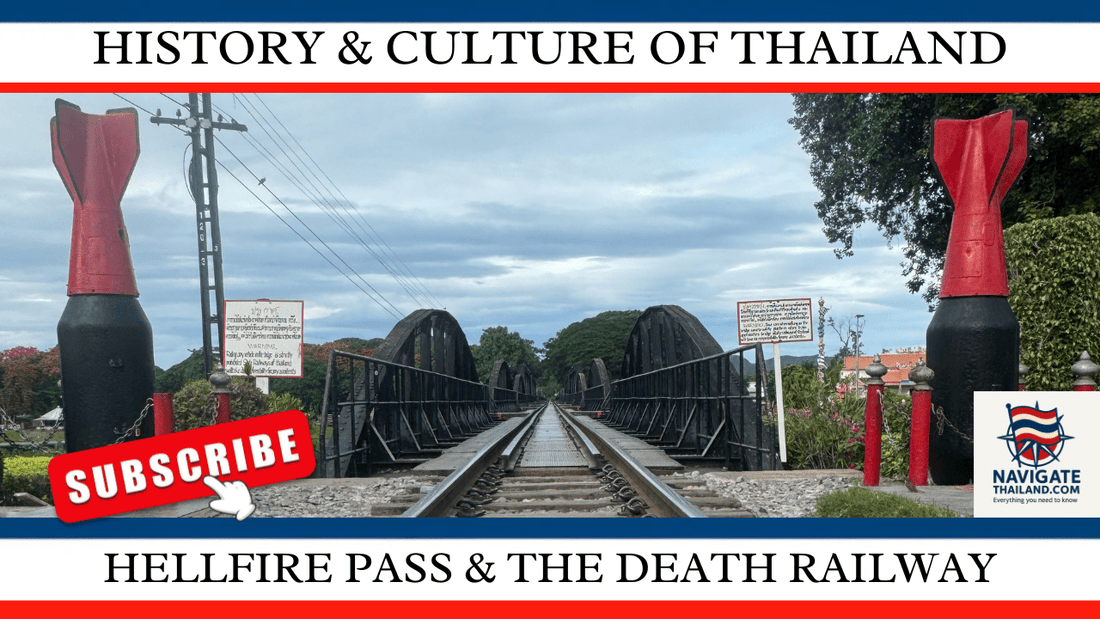
Hellfire Pass and the Death Railway: A Story of Survival and Sacrifice
Share
Nestled in the dense jungles of western Thailand, near the border with Myanmar (formerly Burma), lies a place steeped in history, resilience, and tragedy – Hellfire Pass. This infamous cutting was part of the Thai-Burma Railway, more commonly known as the Death Railway, a brutal construction project undertaken during World War II by the Imperial Japanese Army. The railway, stretching 415 km (258 miles) from Ban Pong in Thailand to Thanbyuzayat in Myanmar, was built to supply Japanese forces in Burma as they advanced toward British India. However, this ambitious engineering feat came at a horrific human cost.
Hellfire Pass stands as a symbol of the suffering endured by the tens of thousands of prisoners of war (POWs) and civilian labourers forced to work under unimaginably harsh conditions. Many of these labourers were from the Allied forces, including Australian and New Zealand Army Corps (ANZACs), British, Dutch, and American soldiers, as well as a large number of Asian civilians.
In this blog, we’ll take an in-depth journey into the history of Hellfire Pass and the Death Railway, exploring the reasons for its construction, the brutal conditions faced by the workers, and how this tragic chapter of history is memorialised today.
The Origins of the Death Railway
The construction of the Thai-Burma Railway was born out of necessity for the Japanese Empire during World War II. After Japan’s rapid expansion in Southeast Asia in the early 1940s, they needed a reliable supply route to support their military campaigns in Burma, particularly to maintain pressure on British forces in India. The existing sea routes, via the Strait of Malacca and around the Malay Peninsula, were increasingly vulnerable to Allied attacks.
The Japanese envisioned an overland railway as a solution, and in June 1942, construction began. The terrain between Thailand and Burma was harsh, with rugged mountains, dense forests, and fast-flowing rivers. The project was considered so difficult that British surveyors, pre-war, had deemed it impossible. Yet, the Japanese military believed the railway could be completed within 12 months, using the forced labour of POWs and civilian workers.
Hellfire Pass: The Most Infamous Section
One of the most notorious sections of the railway is Hellfire Pass (Konyu Cutting). This area of the track required a deep cut through solid rock in the Tenasserim Hills. The pass is around 75 metres long and 25 metres deep, and the work was done almost entirely by hand. Workers used basic tools such as picks, hammers, and shovels to chip away at the rock.
The name “Hellfire Pass” was given by the prisoners because of the way it looked at night. Under the light of flickering torches, the gaunt, emaciated figures of prisoners working late into the night resembled something out of Dante’s Inferno. The eerie glow of the torches, combined with the sounds of hammers and chisels on stone, created a hellish atmosphere. The name stuck and became a lasting symbol of the suffering endured by the workers.
The POWs and Civilian Labourers
ANZACs and Allied Forces
Among the workers on the Death Railway were thousands of Allied POWs, including ANZACs, who had been captured by the Japanese during their campaigns in Southeast Asia. Many were taken following the fall of Singapore in February 1942, one of the most significant defeats for the British and their allies during the war. These soldiers were transported in overcrowded and unsanitary conditions to Thailand, where they were forced to work on the railway.
The POWs, including soldiers from Australia, New Zealand, Britain, and the Netherlands, were subjected to brutal conditions. They were malnourished, weak from disease, and received little medical care. The work was gruelling, often requiring up to 18-hour shifts in the blistering heat of the day or the freezing cold of the night.
Fun Fact: Australian POWs were well known for their camaraderie and resilience, often forming strong support networks among themselves. They created “mateship” systems where they helped each other survive by sharing food, tending to the sick, and maintaining morale.
Civilian Labourers: The Unsung Heroes
In addition to the Allied POWs, tens of thousands of Asian civilian labourers, known as romusha, were forced to work on the railway. These workers, hailing from countries such as Thailand, Myanmar, Malaysia, and Indonesia, were often treated even worse than the POWs. Lured by promises of good wages and working conditions, they quickly found themselves in a living nightmare.
The exact number of civilian deaths is difficult to ascertain, but it is believed that the mortality rate among romusha was even higher than that of the POWs. While the Allied soldiers who died on the railway are honoured and remembered, the romusha are often overlooked, despite their significant contributions and sacrifices.
The Harsh Conditions of Construction
The Death Railway earned its grim name because of the horrific conditions faced by those forced to work on it. The tropical heat, monsoon rains, and rampant diseases such as malaria, cholera, and dysentery claimed thousands of lives. Workers were given minimal food, often little more than a handful of rice, and their bodies were ravaged by starvation.
Additionally, the Japanese captors were notoriously brutal, subjecting workers to frequent beatings, torture, and execution for even the slightest infractions. Workers were also forced to carry heavy loads, including equipment and timber, over long distances.
Speedo: The Speed-up Phase
As the Japanese military’s situation worsened in Burma, they demanded that the railway be completed even faster. This phase, known as “Speedo,” saw a dramatic increase in the already harsh working conditions. The work hours were extended, and the brutality of the overseers intensified. It was during this phase that many of the deaths occurred, with workers collapsing from exhaustion, disease, or malnutrition.
Memorialising Hellfire Pass and the Death Railway
Today, Hellfire Pass and the Death Railway stand as somber reminders of the incredible suffering and sacrifice endured by those forced to work on the project. Efforts have been made to ensure that their memory is not forgotten, and both the Thai and Australian governments have worked to preserve the site as a place of remembrance and reflection.
The Hellfire Pass Memorial Museum
Located near the site of Hellfire Pass, the Hellfire Pass Memorial Museum was opened in 1998 by the Australian government. The museum provides a detailed history of the Death Railway, with exhibits including photographs, personal accounts from survivors, and artefacts recovered from the site. Visitors can also walk the path of the original railway through Hellfire Pass, giving them a sense of the scale of the work and the conditions faced by the workers.
The museum plays a crucial role in educating future generations about this dark chapter in history and ensuring that the sacrifices of the POWs and romusha are never forgotten.
ANZAC Day at Hellfire Pass
Every year, on April 25, ANZAC Day is commemorated at Hellfire Pass to honour the Australian and New Zealand soldiers who lost their lives during World War II. A dawn service is held at the memorial site, attracting visitors from around the world who come to pay their respects and reflect on the enduring spirit of those who served.
Fun Fact: The ANZAC Day ceremony at Hellfire Pass is one of the few held outside of Australia and New Zealand, reflecting the deep connection between the site and the memory of the soldiers who worked and died there.
Legacy and Lessons Learned
The story of Hellfire Pass and the Death Railway is one of both horror and heroism. While it is a stark reminder of the brutal realities of war, it also serves as a testament to the resilience and strength of the human spirit. The men who toiled and died on the railway showed incredible courage and determination in the face of unimaginable hardship.
Today, the Death Railway stands as a symbol of peace and reconciliation. Both Thailand and Japan have worked to heal the wounds of the past, and the site of Hellfire Pass has become a place where people from all over the world come to learn, reflect, and remember.
In remembering the tragic history of Hellfire Pass, we honour the memory of those who suffered and died, and we commit ourselves to ensuring that such atrocities are never repeated.
References:
1. Australian War Memorial - “Hellfire Pass and the Thai-Burma Railway”
2. National Museum of Australia - “The Thai-Burma Railway and POWs”
3. The Commonwealth War Graves Commission - “The Story of the Death Railway”
4. Hellfire Pass Memorial Museum - “Official Museum Guide”
5. ANZAC Day Memorial Service - “History and Commemorations”
Read more of our Thailand blog series:
Thai Food Guide:Traditional Recipes and Street Eats
Everything Travellers Need to know
Thailand travel ebooks and language guides
Thailand Travel Apparel & Souvenir Gifts
Subscribe to our YouTube channel Navigate Thailand to see our most popular Thailand travel blogs turned into videos:
Navigate Thailand YouTube channel


















































































































































